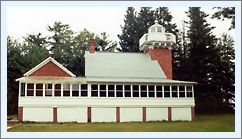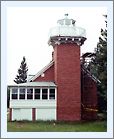|
Historical
Information

At the dawn of the 1870's, the small town of L'Anse found itself in the
thick of the iron boom. With plans in place to complete the construction
of the Marquette, Houghton and Ontonagon Railroad tracks into town in
1872, the naturally protected harbor at L'Anse was considered to be
primary competition for Marquette and
Escanaba ore shipments. With an
infusion of East Coast investment dollars, ore docks and wharves quickly
sprang up along the waterfront and the town's population skyrocketed as
people moved into the area to take advantage of the coming boom.
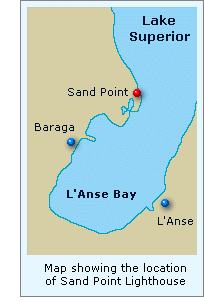 Expecting a dramatic rise in maritime
traffic, the city fathers began applying every possible pressure to the
Federal Government for the construction of a lighthouse to guide
mariners into the harbor. Agreeing with the areas potential, the
Lighthouse Board reported in 1871 that on completion of the railroad
"the place will at once become an important point for the shipment
of iron ore. A good harbor is found at the head of the bay, and it
should be lighted. To establish such a Light is needed will require an
appropriation of $12,000, which amount is submitted, with
estimate." Without an appropriation that year, the Board reiterated
the recommendation in its annual report for 1872, and Congress responded
with an appropriation of $10,000 for establishing the light at L'Anse on
March 3, 1873. By July, under the direction of District Engineer Major
Godfrey Weitzel, a site had been selected to the north of L'Anse, and
title negotiations were underway, after which Weitzel expected that
"no unnecessary delay will take place in erecting the requisite
structures and exhibiting the light." Expecting a dramatic rise in maritime
traffic, the city fathers began applying every possible pressure to the
Federal Government for the construction of a lighthouse to guide
mariners into the harbor. Agreeing with the areas potential, the
Lighthouse Board reported in 1871 that on completion of the railroad
"the place will at once become an important point for the shipment
of iron ore. A good harbor is found at the head of the bay, and it
should be lighted. To establish such a Light is needed will require an
appropriation of $12,000, which amount is submitted, with
estimate." Without an appropriation that year, the Board reiterated
the recommendation in its annual report for 1872, and Congress responded
with an appropriation of $10,000 for establishing the light at L'Anse on
March 3, 1873. By July, under the direction of District Engineer Major
Godfrey Weitzel, a site had been selected to the north of L'Anse, and
title negotiations were underway, after which Weitzel expected that
"no unnecessary delay will take place in erecting the requisite
structures and exhibiting the light."
And then financial Hell broke loose.
In September 1873, New York financier
Jay Cooke declared bankruptcy. Among other interests, Cooke had served
as primary financier of the North's cause in the Civil War and was the
principal backer of the Northern Pacific Railroad. The company's
collapse rippled throughout the country, with almost all of the nation's
railroads declaring bankruptcy. This Financial Panic of 1873, had
disastrous impact on the nation's business, ore shipments from Lake
Superior virtually dried-up, and the docks at L'Anse sat empty.
With expectations high that boom days
would return, the Lighthouse Board continued to pursue the erection of a
Light at L'Anse. However, in 1875 after two years of unsuccessful title
negotiation, the Board asked Congress for permission to re-word the
appropriation in 1875 to allow construction of the light anywhere in the
vicinity that it determined would serve the harbor.
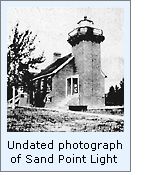 Congress approved the verbal
modification, and a new a new site with a willing owner was selected
across the bay from L'Anse at Sand Point, and the title was filed since
with the US District Attorney in 1876. Since Weitzel was already working
on a plan for a new light at Port Austin, it was decided to use this
same plan at Sand Point. Specifying a 1 ½ story brick dwelling with
attached square tower, Weitzel's plan was evidently successful, as two
other stations would subsequently be built to the same plan at Sherwood
Point in 1883 and at Little Traverse in 1884. Congress approved the verbal
modification, and a new a new site with a willing owner was selected
across the bay from L'Anse at Sand Point, and the title was filed since
with the US District Attorney in 1876. Since Weitzel was already working
on a plan for a new light at Port Austin, it was decided to use this
same plan at Sand Point. Specifying a 1 ½ story brick dwelling with
attached square tower, Weitzel's plan was evidently successful, as two
other stations would subsequently be built to the same plan at Sherwood
Point in 1883 and at Little Traverse in 1884.
While forest fires were frequent
throughout the thickly forested Upper Peninsula, 1876 was the year of a
particularly disastrous fire which swept through L'Anse, burning
everything in its path, including the wooden docks at the waterfront.
 The lighthouse tender
WARRINGTON
delivered a work crew and materials at Sand Point in August 1877, and
work began and continued until winter's icy grip forced an end to the
construction. Work resumed on the opening of navigation the following
spring, and was well underway when Keeper John Crebassa reported for
duty as the station's first keeper on July 19, 1878, transferring-in
from the Portage River Light at Jacobsville, where he had served as that
station's keeper for the past 13 years. Construction was close to
completion at the beginning of August, when the District Lampist arrived
at Sand Point, and carefully installed the new fixed red Fifth Order
Fresnel lens in August. While only a small lens, it had been calculated
that the light's location 38 feet above the lake surface would afford it
with a visible range of 9 ¾ miles, which was deemed sufficient to serve
to guide mariners into the bay and to the harbor beyond. Keeper Crebassa
climbed the tower stairs to exhibit the new light for the first time on
the night of August 10, 1878. The lighthouse tender
WARRINGTON
delivered a work crew and materials at Sand Point in August 1877, and
work began and continued until winter's icy grip forced an end to the
construction. Work resumed on the opening of navigation the following
spring, and was well underway when Keeper John Crebassa reported for
duty as the station's first keeper on July 19, 1878, transferring-in
from the Portage River Light at Jacobsville, where he had served as that
station's keeper for the past 13 years. Construction was close to
completion at the beginning of August, when the District Lampist arrived
at Sand Point, and carefully installed the new fixed red Fifth Order
Fresnel lens in August. While only a small lens, it had been calculated
that the light's location 38 feet above the lake surface would afford it
with a visible range of 9 ¾ miles, which was deemed sufficient to serve
to guide mariners into the bay and to the harbor beyond. Keeper Crebassa
climbed the tower stairs to exhibit the new light for the first time on
the night of August 10, 1878.
With the ore dock burned, and the
country only now beginning to claw its way from the grips of the
Depression resulting from the Panic of '78, the huge number of ore boats
never materialized. However, with a number of saw mills around the bay,
the Sand Point Light continued to serve as a guide a large number of
lumber hookers entering the bay to load with timber to for the growing
cities on the southern lakes.
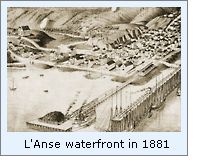 With the exception of the installation
of 86 feet of new sidewalk in 1894, no major repair work was undertaken
at the station for the following decade, until 1897, when it was
identified that rising lake levels had eroded the sandy shoreline in
front of the station to a point that drastic measures needed to be taken
in order to prevent the tower from being undermined. A work crew was
delivered at the station in 1898, and set about laying a grid of large
square hemlock timbers to the rear of the dwelling. The entire brick
lighthouse was then jacked up onto these timbers, and with the timbers
liberally coated with grease, the building was pushed and pulled 200
feet inshore from the lake onto a new foundation. With the move
complete, additional hemlock timbers were installed between the station
and the shore and filled with packed sand to help preclude any further
erosion. With the exception of the installation
of 86 feet of new sidewalk in 1894, no major repair work was undertaken
at the station for the following decade, until 1897, when it was
identified that rising lake levels had eroded the sandy shoreline in
front of the station to a point that drastic measures needed to be taken
in order to prevent the tower from being undermined. A work crew was
delivered at the station in 1898, and set about laying a grid of large
square hemlock timbers to the rear of the dwelling. The entire brick
lighthouse was then jacked up onto these timbers, and with the timbers
liberally coated with grease, the building was pushed and pulled 200
feet inshore from the lake onto a new foundation. With the move
complete, additional hemlock timbers were installed between the station
and the shore and filled with packed sand to help preclude any further
erosion.
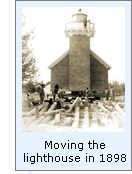 Likely as a result of ailing health,
Keeper Crebassa resigned from lighthouse service on March 1, 1908 after
30 years at Sand Point. With no immediate replacement available, his
wife Anne took over as Acting Keeper for three months until Thomas
Thompson transferred in from the Eagle Harbor Ranges on May 18. Thompson
in turn resigned in 1911, and was succeeded by his brother Richard on
May 22, after serving seven years as Second Assistant at Spectacle Reef. Likely as a result of ailing health,
Keeper Crebassa resigned from lighthouse service on March 1, 1908 after
30 years at Sand Point. With no immediate replacement available, his
wife Anne took over as Acting Keeper for three months until Thomas
Thompson transferred in from the Eagle Harbor Ranges on May 18. Thompson
in turn resigned in 1911, and was succeeded by his brother Richard on
May 22, after serving seven years as Second Assistant at Spectacle Reef.
With advances in acetylene lighting
technology, and a continuing slide in maritime traffic in and out of
L'Anse, the decision was made to automate the Sand Point Light in 1922.
Thus, a small brick acetylene tank house was erected 37 yards to the
east of the tower, and topped with a 35 foot tall red iron mast. A 300
mm lantern was erected atop this mast, and equipped with a sun valve,
the light was automatically illuminated with the cool of evening and
extinguished with the warmth of morning sun. The new light was placed
into operation on September 25, 1922, and Richard Thompson accepted a
transfer to Duluth, where he took over as First Assistant, in which
position he continued to serve until he retired from lighthouse service
on April 20, 1933.
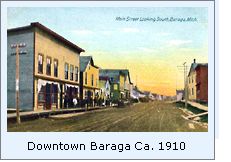 At some time thereafter, the lighthouse
passed into private ownership, and has most recently become the property
of the Keweenaw Bay Indian Community. At some point along the way, a
hideous porch was added along the entire Southern exposure, hiding the
simple beauty of the original structure. At some time thereafter, the lighthouse
passed into private ownership, and has most recently become the property
of the Keweenaw Bay Indian Community. At some point along the way, a
hideous porch was added along the entire Southern exposure, hiding the
simple beauty of the original structure.
From time to time there have been
heartening rumors that there plans are underway to restore the building
to its original appearance, and open it up to the public. However as of
this writing, there has been no move in this direction.

Keepers of
this Light

Click here
to see a complete listing of all Sand Point Light keepers compiled by
Phyllis L. Tag of Great Lakes Lighthouse Research.

Seeing this Light

Sand Point Light sits
alone on the western shore of Keweenaw Bay in the middle of a large open
area ringed with pine trees, and is afforded a beautiful view of the bay
to the east. Unfortunately, Sand Point has been subjected to a similar
fate as the Eagle River light which we had visited a couple of days
earlier.
There are still a
number of outbuildings standing, most noticeably a wonderful two-seat
outhouse. Unfortunately, we could
find no-one working on the day of our visit, and thus were unable to get
a good look at the building's interior, which from the glimpses that we
were able to catch through the windows, appeared to be in excellent
condition.

Finding this Light

Heading North on US41 out of Baraga, turn right on the road just past
the Department of Natural Resources District Headquarters building. Look
for a sign stating "Ojibway Campgrounds." Stay on the road
until a gravel road can be seen that turns off to the right. Take the
right turn and continue until you reach a fork in the road. Take the
left fork and continue to the lighthouse.

Reference
Sources

Inventory of Historic Light Stations, National Parks Service,
1994.
Personal visit on 09/09/1999
Photographs from author's personal
collection.
Keeper listings for this light appear courtesy of
Great
Lakes Lighthouse Research
|

